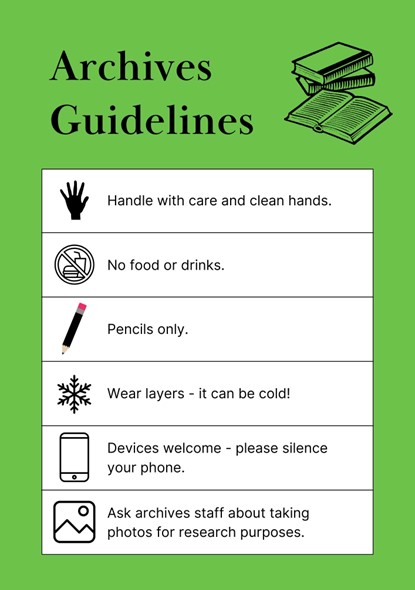Promoting Collections Care in Academic Libraries
Liz Bloodworth, Illinois Wesleyan University
The goal of collecting rare books and manuscripts in academic libraries often revolves around the use of those collections by students. From a preservation perspective, promoting student use must be balanced with prioritizing care. For archivists and special collections librarians, time with students is often limited to one-shot instruction sessions. This reality leaves little space for thorough overviews of collections care. As a result, we often have to find creative ways to encourage responsible and safe handling of archival materials.
Assigning pre-work offers one way to impart guidelines for collections care to students. As an example, I have leveraged our learning management system, Canvas, to create a multimodal module introducing students to archival research and to the archives as a place. The module includes an overview of the Archives and Special Collections, instructions for setting up a research appointment, a video demonstrating how to find archival materials in the library catalog, and an infographic (Figure 1) focused on guidelines for researching in an archival setting. Videos on proper handling, such as this one on using archival materials from the New York University Archives, can also be embedded in modules to provide another mode of instruction.
This pre-work strategy requires coordinating with the instructors of record to share and assign the module before the class visit. This coordination allows me to reach the students before they step foot in the archives, but it’s not a guaranteed way to ensure safe interaction with material. The students still need to complete the work to see the benefit. Still, for those students who complete the module, the module allows me to better prepare students for the unfamiliar, and sometimes intimidating, archival research environment.

Figure 1: This infographic is included in a Canvas module assigned to students ahead of archival instruction sessions to inform them how they can help preserve the materials they encounter during their visits.
Promoting best practices for collections care in-person with students can help protect the materials in our care. For each class visiting the archives, I begin the session with instructions for working with the material, such as when to use gloves, the importance of writing only in pencil, and reminders to keep drinks and food out of the reading room. Modeling best practices for handling material can provide reinforcement for oral instructions. For example, students using oversized scrapbooks can benefit from a visual demonstration focused on supporting individual pages when browsing the item.
Signaling the importance of collections care through appropriate signage and preservation aids can strengthen our attempts as academic librarians to advocate for the physical objects while promoting their use. Posting clear expectations for researcher behavior, such as “no food and drink” signs, reminds students to take extra caution while conducting archival research. Placing particularly delicate books in book cradles and housing photographs in protective sleeves also can signal to researchers the need for specialized handling of these materials.
While advocating for the proper care to protect our collections often requires a multipronged approach, the benefit students receive from interacting with tangible items in the archives outweighs the instructional work involved. After all, academic libraries collect these materials for student use. Let’s use them - with proper precautions and guidelines in place.
View additional articles in the Preservation Outreach and Engagement Series!

